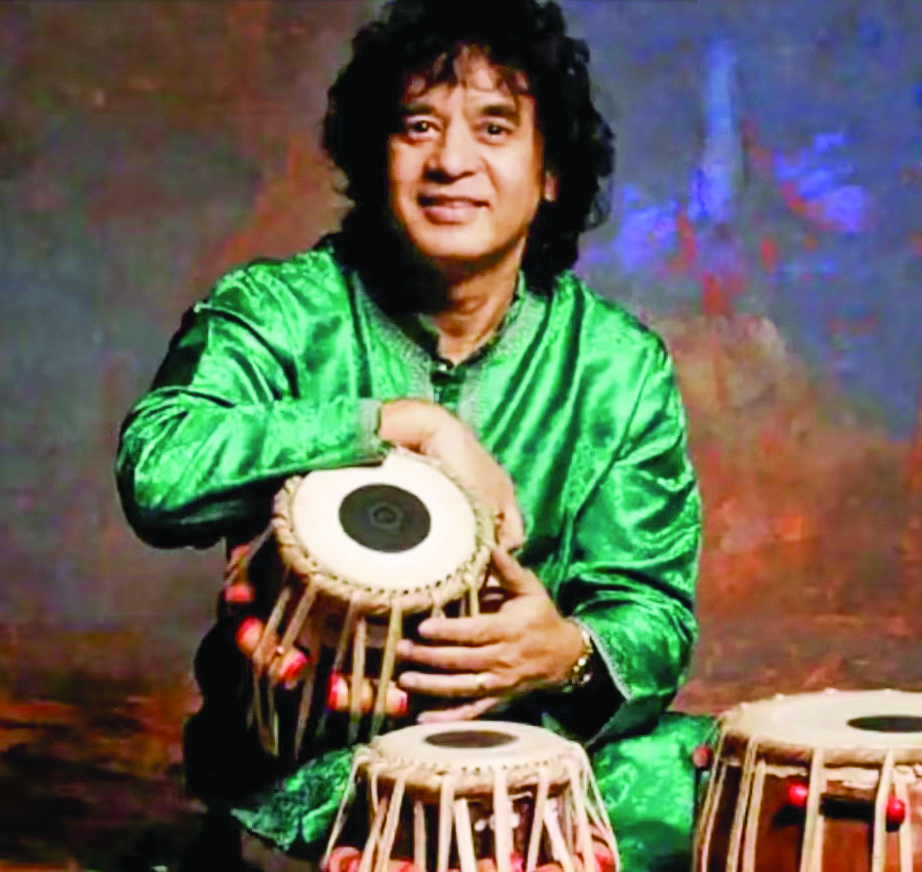“Every time you step out on to the stage, you learn something which helps you grow and be a better communicator. It’s not like you’re the master. You’re always a student”
-Zakir Hussain
The world lost a luminary as Zakir Hussain, the virtuoso tabla player, left an indelible mark on the annals of music history. Hussain’s unique blend of technique, creativity, and deep cultural understanding revolutionized the art form, earning him accolades and admirers worldwide. His contributions were not confined to Indian classical music alone; they rippled through genres, bringing a fresh perspective and fostering cross-cultural collaborations.
Zakir Hussain, born on March 9, 1951, in Mumbai, was a legendary tabla maestro who brought Indian classical music to global audiences. The son of the renowned tabla player Ustad Alla Rakha, Zakir began his musical journey at the tender age of seven and performed his first concert at twelve. His career took off in the 1970s, and he quickly became a global icon, collaborating with international artists like George Harrison, John McLaughlin, and Mickey Hart. Zakir’s innovative approach to music led to the formation of the fusion group Shakti and the creation of the Grammy-winning album “Planet Drum.” His legendary solos, like those at the Monterey Jazz Festival, remain etched in the memories of music enthusiasts worldwide, exemplifying his extraordinary talent and the inspirational energy he brought to the stage. He received numerous accolades, including the Padma Shri, Padma Bhushan, and Padma Vibhushan, and was honored with multiple Grammy Awards. Zakir Hussain’s journey was not just about mastering the tabla but also about bridging cultures and spreading the universal language of rhythm.
Ustaad Hussain was instantly recognizable, with his distinctive look that left a lasting impression on all who saw him. His curly hair, often cascading down in loose waves, framed his expressive face that always seemed to carry a serene and contemplative demeanor. Whether dressed in traditional Indian attire like a kurta and pajama or more casual, modern clothes, Zakir exuded an effortless blend of grace and approachability. On stage, he often performed barefoot, a gesture of respect and connection to his roots, while his nimble fingers danced over the tabla, mesmerizing audiences with their dexterity and rhythm. He had a unique way of weaving complex rhythmic patterns that complemented the melodic structure, making each performance a captivating exploration of musical possibilities. This special hold on ragas and his innovative approach continue to inspire countless musicians and listeners, solidifying his legacy as one of the greatest tabla players of all time.
His illustrious career boasts several remarkable collaborations with Hollywood and Bollywood, which have left an enduring legacy in the music world. In Hollywood, one of his standout collaborations was with Mickey Hart of the Grateful Dead on the Grammy-winning album ‘Planet Drum’. This groundbreaking project fused diverse global rhythms, showcasing Zakir’s unparalleled talent and versatility. Another notable Hollywood collaboration was his work on the soundtrack for the film ‘Apocalypse Now,’ where his tabla brought a distinctive depth to the score, adding a unique texture to the cinematic experience.
In Bollywood, Zakir Hussain’s contributions were equally impactful. He worked with acclaimed composer A.R. Rahman on several projects, including the iconic soundtrack for ‘The Legend of Bhagat Singh’. His tabla rhythms added a profound resonance to the music, enriching the film’s emotional and historical narrative. Additionally, his collaboration with renowned director Satyajit Ray on films like ‘Ghare-Baire’ and ‘Shatranj Ke Khilari’ showcased his ability to seamlessly blend classical Indian music with cinematic storytelling. These collaborations not only highlighted his exceptional skills but also bridged cultural gaps, bringing the richness of Indian classical music to a global audience and cementing his status as a musical pioneer.
Zakir Hussain: A Life in Music by Nasreen Munni Kabir offers an intimate exploration of the legendary tabla maestro’s life and contributions. The biography captures his early days under the tutelage of his father, Ustad Alla Rakha, highlighting the innovative techniques he developed. Zakir’s journey from a prodigious child to a global ambassador of Indian classical music is chronicled through his numerous collaborations with international artists, which bridged cultural divides and expanded the audience for Indian rhythms.
The present generation often gravitates towards auto-tune and digital enhancements, sometimes missing the profound depth and authenticity of classical music. However, legends like Ustad Zakir Hussain remind us that classical music is immortal, original, and the foundation from which all music stems. His iconic ‘Waah Taj’ has become a timeless emblem, ensuring that Zakir Hussain’s extraordinary music continues to resonate in our hearts and minds. This phrase captures the essence of his artistry and the wonder he inspires, reminding us of the unparalleled beauty and depth of classical music. With each beat and rhythm he shared, Ustad Zakir Hussain breathed life into the tabla, creating melodies that will forever echo through generations. His legacy keeps the spirit of his music alive, inspiring both seasoned musicians and new listeners to appreciate the rich heritage of Indian classical music.

